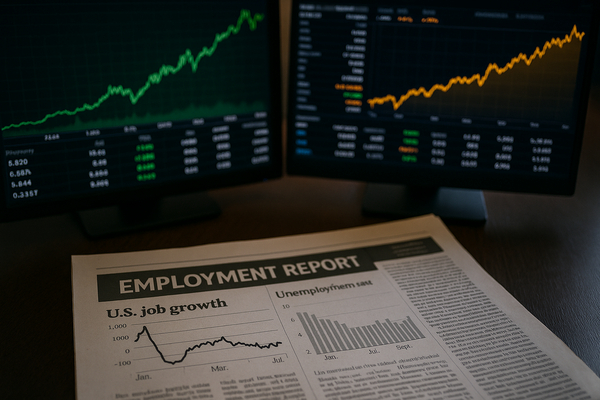
Nvidia’s strong third quarter revenue of $57 billion and bullish guidance failed to calm investors after a sharp market reversal. NASDAQ:NVDA’s figures have highlighted worries about massive AI spending, extreme concentration, and sky high valuations. U.S. payrolls surprised on the upside with a 119,000 gain while the unemployment rate climbed to 4.4%, the highest since October 2021. Global investors will weigh AI capex indigestion against sticky labour data. In the short term volatility may persist. Over the longer term the mix of heavy tech concentration, fiscal moves in Japan, and energy market rebalances will matter for returns across the US, Europe, Asia and emerging markets. This matters now because recent intraday swings, delayed official data releases and policy moves have increased near term uncertainty for markets.
Market reaction to Nvidia and the tech swing
U.S. equities staged an early rally only to give most gains back within the session. The Nasdaq recorded a 4.9 percentage point intraday swing, its largest since April’s tariff episode. The Dow and Nasdaq each experienced moves in excess of 1,000 points from peak to trough on Thursday. Those moves came even after Nvidia NASDAQ:NVDA reported record third quarter revenue and issued upbeat forecasts. The paradox is that strong company results have sharpened broader concerns instead of soothing them.
Investors are now focused on three linked dynamics. First, very large AI capital expenditure is lifting demand for semiconductors and cloud services. Second, concentration in a handful of mega cap tech names raises systemic risk when sentiment turns. Third, valuations in those names are lofty by many measures. Together these drivers are encouraging caution rather than celebration in equity markets. In the near term traders will look for whether volatility settles or becomes a recurring feature of sessions. Over time, corporate profit growth and actual AI deployment economics will determine whether current valuations can be justified.
Labor market noise complicates the Fed story
A delayed September jobs report added fresh ambiguity to the policy debate. Nonfarm payrolls rose by 119,000, more than twice consensus, while the August headline was revised down by 4,000 jobs. The unemployment rate rose to 4.4 percent, the highest level since October 2021. That combination offers a mixed signal for the Federal Reserve. On one hand payroll gains were solid. On the other hand the uptick in unemployment and data revisions cloud the labour picture.
Complicating interpretation is the backdrop of the longest U.S. government shutdown in history, which will likely leave the monthly releases noisy for a period. Central bankers prize clear labour trends. This release is unlikely to decisively clarify the path of policy in the near term. Market participants will therefore parse other incoming data and speeches for clues about how the Fed interprets these mixed signals.
Asia moves: yen weakness, stimulus and FX risk
The Japanese yen hovered near a 10 month low at about 157 per dollar as Prime Minister Sanae Takaichi approved a 21.3 trillion yen fiscal stimulus package worth about $135.5 billion. That package has raised talk of potential foreign exchange intervention. The yen’s role as a global safe haven is under renewed scrutiny given persistent weakness and the scale of domestic fiscal measures.
Currency intervention remains a policy tool of last resort, but the combination of sizeable fiscal stimulus and currency depreciation elevates the prospect of official action. For regional markets, a structurally weaker yen changes trade flows and capital allocation across Asia. Meanwhile, China continues to draw attention from commodities desks with rising oil stockpiles, a slump in steel output even as iron ore imports climb, and an increase in fossil fuel powered electricity generation. Those trends affect commodity demand both directly and through pricing dynamics for energy intensive industries.
Energy and commodities: transition pains and trade flows
The energy narrative remains complex. Coverage from the week emphasised that the green transition will be bumpier and more fractured than planners anticipated a decade ago. At the same time the United States has risen to the top of global LNG exporter rankings. That shift fuels narratives about expanding shipments of freedom gas, but there are clear vulnerabilities.
American LNG vendors face the risk of rapid volume downturns if European buyers curb gas use. The margin of safety for exporters depends on winning share in fast growing Asian markets. If U.S. firms do not expand market penetration in Asia, volumes and price outcomes could be more volatile than many expect. In metals markets even low profile materials are drawing strategic attention. Aluminium scrap was singled out as a strategic commodity because of its role in recycling and the wider supply chain for critical minerals. These details matter because supply chain frictions and policy choices will influence pricing and trade flows for the rest of the year.
What to watch in the session ahead will be market liquidity and sector breadth during any renewed swings. Tech concentration remains a focal point because it amplifies volatility. Labour data revisions and the higher unemployment rate will keep fixed income traders and policy watchers busy. FX desks will watch Japan for signals about intervention and investors in energy and commodities will track flows of LNG and China related stockpiling. Taken together these elements provide the near term frame for global markets, while the longer term story will be written by corporate capex, policy responses, and the pace of the energy transition.












